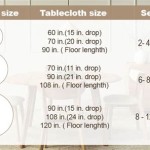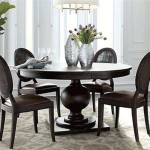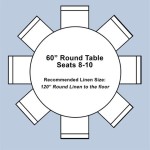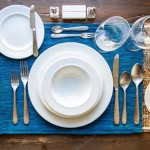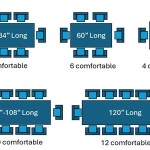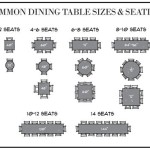How To Use Table Runners: A Comprehensive Guide
Table runners are versatile decorative textiles that can elevate the aesthetic appeal of any dining table, coffee table, or even accent tables. They serve not only as visual enhancements but also as practical elements protecting surfaces from spills and scratches. The effective use of table runners involves understanding their various sizes, materials, styles, and the contexts in which they are best employed. This article provides a detailed guide on how to use table runners to transform any space.
Choosing the Right Size and Shape
Selecting the appropriate size is paramount to achieving the desired effect. A table runner that is too short will appear insignificant, while one that is too long may overwhelm the table setting. The general rule is to allow the runner to extend beyond the edges of the table, typically with an overhang of 6 to 12 inches on each end. This overhang, sometimes referred to as a "drop," contributes to the overall visual balance and elegance of the arrangement.
To determine the ideal runner length, measure the length of the table and add 12 to 24 inches. For instance, a table measuring 60 inches in length would require a runner between 72 and 84 inches long. This calculation ensures a suitable overhang on both ends.
The width of the table runner is also a crucial consideration. Common widths range from 12 to 16 inches, although wider runners are available for larger tables or when a more dramatic effect is desired. The width should be proportionate to the table's width; a runner that is too narrow may appear insignificant, while an excessively wide runner may detract from the table setting and interfere with place settings.
Beyond traditional rectangular runners, alternative shapes such as square or circular runners are suitable for specific table shapes or design aesthetics. Square runners are often used on square tables, placed either diagonally or centered. Circular runners can be layered on round tables to add texture and visual interest.
Selecting Materials and Styles
The material of a table runner significantly impacts its overall appearance and durability. The choice of material should align with the intended use, the formality of the occasion, and the existing décor. Common materials include cotton, linen, polyester, silk, and various blends.
Cotton runners are a popular choice due to their versatility, affordability, and ease of care. They are suitable for both casual and semi-formal settings and are available in a wide range of colors and patterns. Linen runners offer a more refined and elegant aesthetic. Linen’s natural texture adds visual interest and exudes a sense of understated luxury. However, linen requires more careful maintenance due to its tendency to wrinkle.
Polyester runners are known for their durability, stain resistance, and affordability. They are an excellent option for high-traffic areas or events where spills are likely, such as outdoor gatherings or children's parties. Silk runners lend an air of opulence and are best reserved for formal occasions. Silk's delicate nature necessitates careful handling and cleaning. Blended fabrics, such as cotton-polyester blends, offer a balance of durability, ease of care, and aesthetic appeal.
The style of the table runner should complement the overall décor of the room. Consider the color scheme, patterns, and textures already present in the space. A runner can serve as a subtle accent or a bold statement piece, depending on the design. Neutral colors, such as beige, gray, or white, are versatile and can easily blend with various décor styles. Bold colors or patterns can add a pop of visual interest and serve as a focal point.
Consider the existing tableware. If the tableware is already heavily patterned, a solid-colored or subtly textured runner might be more appropriate. Conversely, if the tableware is simple and understated, a patterned or textured runner can add visual interest and depth.
Different Ways to Use Table Runners
Table runners offer various styling possibilities, each creating a different visual impact. The most common approach is to place the runner lengthwise down the center of the table, providing a cohesive and balanced look. This arrangement works well for both rectangular and oval tables.
Another option is to use multiple runners across the table, perpendicular to the length. This arrangement is particularly effective for larger tables and can create a more contemporary and visually dynamic effect. When using multiple runners, ensure they are evenly spaced and proportionate to the table's size.
For round or square tables, a circular or square runner can be centered on the table, creating a focal point. Alternatively, a rectangular runner can be placed diagonally across a square table, adding a sense of asymmetry and visual interest.
Layering runners is another creative approach. Combining runners of different textures, colors, or patterns can add depth and visual complexity to the table setting. For example, a burlap runner topped with a lace runner can create a rustic-chic aesthetic. When layering, ensure the colors and patterns complement each other and avoid overwhelming the table setting.
Beyond traditional dining tables, table runners can be used on coffee tables, console tables, or dressers to add a touch of style and protect the surface. On a coffee table, a runner can serve as a base for displaying decorative objects such as candles, books, or vases. On a console table or dresser, a runner can add a pop of color and protect the surface from scratches and spills.
Table runners can also be incorporated into seasonal décor. A runner with autumnal colors and patterns can enhance a Thanksgiving table, while a runner with festive prints can add cheer to a Christmas gathering. Consider using themed runners to create a cohesive and visually appealing seasonal display.
Practical Considerations and Maintenance
Beyond aesthetics, table runners also serve a practical purpose by protecting the table surface from spills, scratches, and heat damage. Choosing a material that is stain-resistant and heat-resistant is crucial, especially for everyday use.
Proper maintenance is essential to keep table runners looking their best. Always follow the manufacturer's care instructions, which typically include washing instructions and recommendations for stain removal. Some materials, such as linen and silk, may require professional cleaning to prevent damage.
For everyday spills, blot the stain immediately with a clean cloth to prevent it from setting. Avoid rubbing the stain, as this can spread it further and damage the fabric. For stubborn stains, consult a stain removal guide or seek professional cleaning advice.
When not in use, store table runners in a clean, dry place to prevent them from becoming soiled or damaged. Rolling the runner instead of folding it can help minimize wrinkles. If the runner is heavily wrinkled, iron it on a low setting before use. Always test a small, inconspicuous area first to ensure the iron does not damage the fabric.
Consider using placemats or coasters in conjunction with table runners to provide additional protection against spills and heat damage. Placemats can also add another layer of visual interest to the table setting.
Pay attention to the overall balance of the table setting. Avoid overcrowding the table with too many decorative elements. A well-chosen table runner should enhance the table setting, not detract from it. Simplicity and restraint are key to creating an elegant and visually appealing arrangement. The effective use of table runners involves careful consideration of size, material, style, and arrangement, along with proper maintenance to ensure lasting beauty and functionality.

How To Use Table Runners At Home House Garden

5 Ways To Use A Table Runner Stylemutt Home

5 Ways To Decorate A Table With Runner Pottery Barn

5 Ways To Decorate A Table With Runner Pottery Barn

Table Runners Add Color Style To Rooms Supreme Accents

All About Table Runners How To Use A Runner

Table Runners For Round Tables Find The Right Runner

Table Runners Add Color Style To Rooms Supreme Accents

Table Runner Tips Tricks

Thanksgiving Table Runners How To Style A Runner
Related Posts


